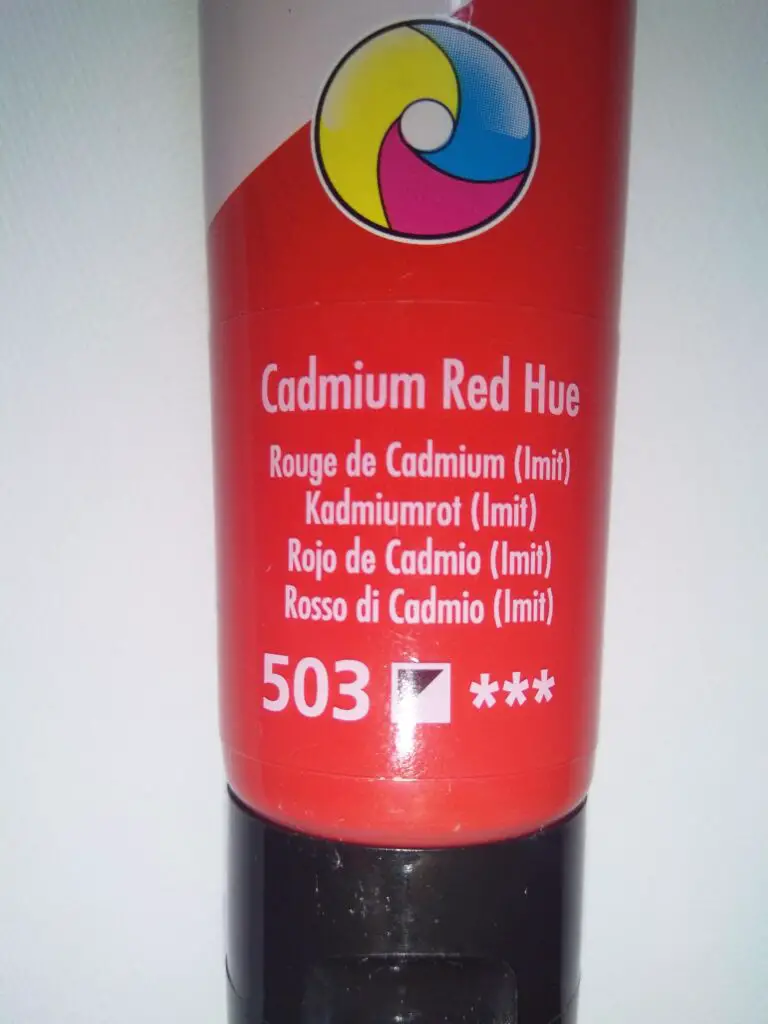Acrylic paint is one of those safe art mediums. But it is not always like that. It can turn on you if not handled properly and with care. So, let’s see if acrylic paint is harmful.
Acrylic paint is nonharmful and nontoxic unless you ingest or inhale it. Inhaling particles of acrylic paint would be more harmful as these particles remain in the lungs for a long time causing damage. Ingestion of acrylic paint can also be harmful, depending on the pigments used.
Artists should minimize exposure to acrylic paint on their bodies like with any chemical. Therefore they should not leave acrylic paint on the skin for a long time, because some of the metals in acrylic paint are permeable through our skin.
Is acrylic paint harmful?
Acrylic paint can be harmful when someone is exposed to acrylic paint via skin, inhalation, or ingestion. Any of these routes of intoxication can be harmful depending on the pigment in acrylic paint. If any irritation occurred or persisted immediately see a doctor.
Harmful compounds in acrylic paint form a very minimal risk compared to other major ways people get exposed to toxic substances. Manufacturers have taken actions to minimize the bioavailability and solubility of potentially toxic compounds in acrylic paint.
However, there can still be potential toxicity aspects that have not been looked into yet. Therefore we as artists should minimize exposure to acrylic paint as with any other chemical.
I have written a whole article about ‘Can acrylic paint cause cancer? (Risks and precautions)‘. You will find the carcinogenic nature of each compound in acrylic paints. Also, you will learn to read a paint tube label and find safety data on it.
What things in acrylic paint are harmful?
Acrylic paint is composed of pigment, acrylic polymer binder, water, and other additives to maintain integrity of acrylic paint. The harmfulness of acrylic paint mostly lies in pigment and additives.
Pigments in acrylic paint
Pigments like cadmium, lead, nickel, cobalt, chromium, carbon black, and crystalline silica are known carcinogens. Some other pigments or compounds like cerulean blue, manganese, and quinacridones can cause other toxicities or irritations in the body. These compounds are in pigments that give colors to acrylic paint.
Some of the colors with these harmful chemicals would be cadmium red, cadmium yellow, cadmium orange, cobalt blue, carbon black, lead white, etc. Manufacturers have found alternatives for some of these pigments nowadays.
As an example lead white is very popular among oil artists than acrylic artists. Lead is highly toxic to your body including your genetic material. Thus it can cause various diseases including cancer. Long ago it is replaced with titanium white. Therefore lead is very rare in artists’ paints. Titanium white is a great pigment with high opacity. It is a safe alternative for lead white.

Cadmium can disrupt normal cell functions, increase the risk of cancer, and even damage cells in our bodies. It can affect our skeletal system, and cause renal damage, reproductive system, and cardiovascular system toxicities (source). Kidney damage happens with chronic exposure while lung and digestive system damage happens with acute exposure (source)
Now, there are cadmium-free versions of cadmium red, yellow, and oranges. You can find them in an acrylic paint line like Liquitex. Manufacturers are not clear about what pigments they used instead of cadmium but the colors are very close and the opacity is also very good for cadmium-free acrylic colors.
Sometimes pigments can irritate your skin especially if you are sensitive to metals. Some people may have reactions to cobalt and cadmium pigments upon contact with the skin.
Additives in acrylic paint
Manufacturers use preservatives in acrylic paint like biocides to prevent microorganism growth in acrylic paint. They also use ammonia as a stabilizer in acrylic paint. Biocides and ammonia can cause skin and respiratory irritation in those who are sensitive to them.
GAC-400 Acrylic and GAC-900 acrylic from Golden acrylic paints can cause irritations or allergic reactions in the respiratory system in those who are sensitive to formaldehyde. Formaldehyde is a potential carcinogen.
Therefore if you are found to be sensitive to biocides, formaldehyde, or ammonia it is necessary to take proper precautions when handling any water-based art products such as acrylic paint, acrylic mediums, or acrylic varnish.
How manufacturers made acrylic paint less harmful
Sulfides of cadmium are used to make cadmium pigments in paint. What is interesting is that the cadmium sulfide pigments we use are encapsulated by a polymeric matrix (source). Therefore cadmium pigments have extremely low solubility and bioavailability according to the previous risk assessments.
Meaning cadmium pigments are thought to be extremely safe when encapsulated. However, things change as science evolves. It has been found instability and increased solubility of cadmium in pigments when acids are present.
Therefore cadmium can be more soluble in an acidic environment like the human stomach. It has been calculated that in low PH levels as in our stomach, 10% of cadmium sulfides will be mobilized (source).
Also, it has been found that the oxidized cadmium pigments are more bioavailable and soluble. Therefore a reevaluation of the risk is needed for cadmium pigments.
Even though manufacturers have made toxic pigments like cadmium as nontoxic as possible, things could change as the usage of pigments increase and many factors come into play. Therefore as consumers, it is safer to minimize exposure to chemical products like artists’ acrylic.
What happens if you touch acrylic paint?
Acrylic paint chemicals may permeate through our skin upon contact, especially if the skin is injured. Nickel and chromium-containing pigments have high permeability through the skin when the skin is injured. Some pigments and additives may cause skin irritation.
If you got any acrylic paint on the skin first, wash the skin with soap and water. You can also remove hard-to-get-off acrylic paint using alcohol. If any skin irritations occurred make sure to see a doctor.
To understand what happens when you touch acrylic paint, we will need to understand how each chemical in acrylic paint reacts with the skin. Let’s start with the potentially harmful chemicals in acrylic paint.
Cadmium is 25% and 5% absorbed through inhalation and ingestion and only 0.5% through the skin. This means cadmium is not well absorbed through the skin, but if you eat or inhale acrylic paint particles it could get cadmium inside your body (source) and cause problems.
A study done in a laboratory has found that cobalt and nickel powders can be readily absorbed through the skin when the skin is damaged. However, the ability of chromium to absorb through the skin is low for damaged or intact skin.
This study suggests that it is necessary to prevent skin contamination by toxic compounds because they can be readily absorbed through the skin when there is even a small injury on our skin.

Lead is one of the most harmful metals in paint that can permeate through the skin(source). It is mostly used in lead white oil paint rather than in acrylic paint. Because of this, it was replaced long ago with titanium white. However, you can still find lead in some of the paints today.
Some people have skin reactions or sensitivity when acrylic paint contact with their skin. They may either be sensitive to a pigment/metal, ammonia, formaldehyde, or biocides (preservatives). Those who have sensitivities can wear long hand gloves when painting. You can also clean out acrylic paint if got on the skin with soap and water for alcohol.
As you can see touching acrylic paint causes the least harm with potentially harmful chemicals, that are known today. But, chemicals containing lead cause you greater harm even when you touch it. Also, there may be other chemicals that are permeable through our skins but are yet to discover.
Therefore the best precaution you can take is completely to avoid or minimize skin contact with acrylic paint as much as possible. The same principle applies to any chemical product you are using.
I have written a whole article about ‘Using Acrylic Paint on Skin: Composition and Safety Issues‘. You can find the detrimental compounds that can be in acrylic paints and the effect of skin exposure to acrylic paint there.
Use of acrylic paint as body paints
I have seen some people use acrylic paint as body paint. They may use it on Halloween to make scary faces. Even some people use acrylic paint on their faces. These are all unsafe uses of acrylic paint. As discussed above there are so many toxic or nontoxic chemicals available in acrylic paint.
In Golden Acrylics’ safety data sheets, they say the prolonged or repeated contact of acrylic paint on the skin may be irritating. I suggest you refer to this data sheet as it has loads of information on acrylic paint safety.
Some chemicals are permeable through the skin and cause problems while others are not. In either case, we should not be using acrylic paint at any place on our bodies. They are not cosmetic grade and are not tested for safety as body paint.
I wrote a whole article about ‘Can you put acrylic paint on your face? ‘. You will find many things like a face painting guide and the removal of acrylic paint there.
What happens if you inhale acrylic paint?
Inhalation is one of the biggest routes some harmful metals enter your body. Yet it is probably the worst case. When harmful compounds enter your lung through inhalation they can remain there for a long time. So avoid making paint with harmful chemicals airborne.
As an example, you should not spray paint or airbrush with a color that has heavy metal and is potentially harmful. If you ever want to do that wear a NIOSH P100 respirator.
It is stated in the safety data sheets of Golden acrylic paints that, inhalation can irritate the nose, throat, and lungs when exposed to excessive amounts of ammonia. This can happen when you use a large amount of acrylic paint in a poorly ventilated area.

You can also use a vapor respirator to protect against ammonia, but not necessarily in a properly ventilated area. However non of these would occur in normal conditions of use. If you experienced any of the irritations move to a place with fresh air. See a doctor.
You should also avoid inhaling particles of metals. You should avoid sanding your paintings without proper precautions. Because sanding creates powder-like particles with harmful metals like cadmium. So I would never sand a painting. Rather I would paint over the canvas with gesso if I am reusing an old canvas.
As an example, cadmium exposure primarily happens by taking contaminated water, food, and to a significant extent inhalation and cigarette smoking (source). The major route of nickel exposure is lung inhalation (source). Also inhaling Nickel-containing dust is associated with respiratory cancers (source). The high-risk groups are occupational workers who get exposed to dust from harmful chemical compounds.
Also, you should be careful about using acrylic spray paints. Because they contain toluene and benzene compounds, which can cause toxicities throughout your body (source). Other products that contain these two compounds are hair dye, nail polish, cleaning products, and paint thinners.
Acrylic paint has less odor compared to oil paint. This means acrylic paint produces fewer off-gases, unlike oil paints which produce a high amount of VOC (Volatile Organic Compounds). Even though water-based paint like acrylic paint does not produce VOC it is best to have good ventilation in the studio to avoid exposure to ammonia gases (inorganic gas).
What happens if you eat acrylic paint?
Eating acrylic paint or any other chemical compound is never accepted. It can cause irritations in the gastrointestinal system. Even though pigments in acrylic paint are encapsulated and made to be of less solubility, I would still consider avoiding those chemicals in acrylic paint.
If you accidentally ingest acrylic paint, dilute it by giving 2 or more glasses of water. This should only be done if the subject is conscious. Then see a doctor.
As said before ingestion of cadmium is a major way of cadmium exposure. This cadmium will not pass through your body and accumulate in the kidney, eyes, and other places in your body.
Chromium can also be potentially carcinogenic when ingested in large quantities (source). Ingestion is a major route of exposure to lead as well. However, lead is used very rarely or not at all in acrylic paints.
The same is for other harmful chemicals in acrylic paint. There can be nickel, chromium, carbon black, lead, cobalt, etc. that can accumulate inside your body after ingestion. These chemicals can affect your health.
I have written a whole article about acrylic paint eating and the truth behind the “nontoxic” labeling of acrylic paint. You will also get to know about a famous artist who has claimed to eat paint there.
How to use acrylic paint safely?
Even though acrylic paints use some harmful chemicals, you can easily avoid them. Water-based paints are safe to use compared to solvent-based paints. However, you will need to follow a few practices.
When using acrylic paint you need to minimize the exposure to it as much as possible. So avoid, eating drinking, or inhaling acrylic paint and its particles.
Exposure to acrylic paint or any chemical should be minimized, even though that chemical does not have a harmful compound in it. The toxicities of a particular compound may yet be discovered, as science evolves every day. So as a rule of thumb reduce your exposure to acrylic paint.
If you get paint in your hand, clean it at least after the paint session or quickly as possible. Because the chemicals in acrylic paint will permeate through the skin especially if the skin is injured.
Keep paint tubes away from children, because there can be accidental ingestion of acrylic paint. Most importantly, don’t drink your paint water. It contains all the paint particles with potentially harmful chemicals.
Also if you are using student-grade paints, you do not need to worry about metals like cadmium. Because student-grade paints use nontoxic chemicals instead of cadmium. These colors without cadmium are labeled as ‘hue’ or ‘cadmium free.

Also, draining paint water into the sink may clog the pipes of your sink. Also, it may cause some environmental concerns.
Therefore try to throw away paint when they are dry rather than when they are wet. When disposing of paint water wait until the solid paint particles are settled on the bottom of the container. Then throw out the solid parts separately. This way harmful chemicals will not enter our waterways.
If you are thinking about burning acrylic paint or an acrylic painting, you will need to know about the flammability and harmful effects of burning acrylic paint. You can find that information in the following article: Is acrylic paint flammable? (according to industry standards)
If you want to throw away a paint tube with wet paint, first dry out the paint in the tube. You can do this by keeping the paint tube cap open.
l have written a whole article about ‘Alternative for Acrylic Paint: Best Eco-Friendly Solution‘. I have explained biodegradable paints and the best eco-friendly alternative for acrylic paint there.
Conclusion
Although acrylic paint is considered safe paint, there are toxic aspects to it. Acrylic paint may contain potentially carcinogenic compounds like cadmium, nickel carbon black, etc. Some of these chemicals are permeable through the skin. Ingestion and inhalation of acrylic paint should be avoided. It is best to reduce exposure to any chemical as much as possible.

